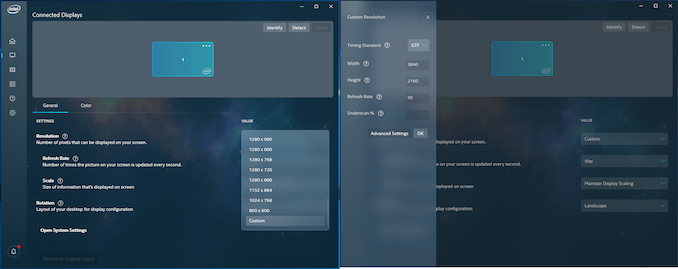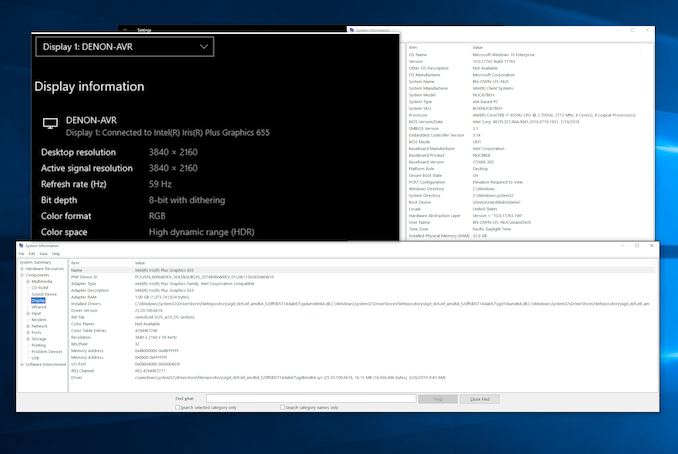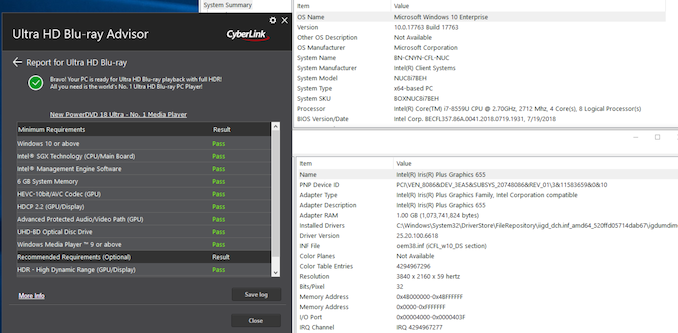Intel's Bean Canyon (NUC8i7BEH) Coffee Lake NUC Review - Ticking the Right Boxes
by Ganesh T S on April 3, 2019 8:00 AM EST- Posted in
- Systems
- Intel
- NUC
- UCFF
- Thunderbolt 3
- Cannon Point
- Coffee Lake-U
HTPC Credentials - Display Outputs Capabilities
The
| NUC8i7BEH Display Outputs | ||
| HDMI | Thunderbolt 3 / USB-C (DP 1.2) | |
| Version | 2.0a | 1.2 |
| Max. Video Output | 3840x2160 @ 60Hz | 4096x2160 @ 60Hz |
| HDCP | Yes (2.2) | |
| HDR | Yes | No |
| HD Audio Bitstreaming | Yes | |
Supporting the display of high-resolution protected video content is a requirement for even a casual HTPC user. In addition, HTPC enthusiasts also want their systems to support refresh rates that either match or be an integral multiple of the frame rate of the video being displayed. Most displays / AVRs are able to transmit the supported refresh rates to the PC using the EDID metadata. In some cases, the desired refresh rate might be missing in the list of supported modes.
Custom Resolutions
Our evaluation of the
We tested out various display refresh rates ranging from 23.976 Hz to 59.94 Hz. Of particular interest is the 23.976 Hz (23p) setting, which Intel used to have trouble with in the pre-Broadwell days.
The gallery below presents screenshots from the other refresh rates that were tested. The system has no trouble maintaining a fairly accurate refresh rate throughout the duration of the video playback.
High Dynamic Range (HDR) Support
The ability of the system to support HDR output is brought out in the first line of the madVR OSD in the above pictures. The display / desktop was configured to be in HDR mode prior to the gathering of the above screenshots.
We find that the HDR configuration results in the GPU driving a RGB signal to the display.
The CyberLink Ultra HD Blu-ray Advisor tool confirms that our setup (




















81 Comments
View All Comments
jeremyshaw - Wednesday, April 3, 2019 - link
Yeah, I made the mistake of going for an IGP + eGPU setup this time around (X1 Carbon + Lenovo GTX1050 dock). Nevermind the TB3 power issues that Lenovo finally fixed (silently), or GPU driver issues, just the need to lug around another box and its own power brick negates any weight savings over a heavier laptop with even a weak dGPU.This is a mistake I will never, ever make again. The eGPU idea really only works for Mac users, who are "forced" to buy from a range of 4 laptops (5, if you count three year old laptops being sold at full price), of which only one has a dGPU. Another has a passable IGP, that is still weaker than the worse of the current dGPUs (unless if one counts the Lenovo E480's severely throttled RX540). If you are a mac user and intend on staying one, choices are very limited, making eGPUs a necessity for those wanting more power. For anyone else out there, such sacrifices are not necessary.
Death666Angel - Thursday, April 4, 2019 - link
Honestly, the eGPU thing only makes sense to me in one scenario: with a laptop that has an anemic GPU inside (low end AMD/Intel or just integrated) that has great battery life on the go but the owner wants to play some games at home on a larger monitor with good image quality and not have the hassle to maintain two independant systems. So the eGPU enclosure stays in one place, the laptop gets lugged around, is light, long lasting and productive on the go and when you get home, one cable to make it into a decent gaming PC.eGPU on already stationary desktops is just weird (get a slightly bigger case and stick a GPU inside that, more options, probably cheaper as well) and people who lug around the eGPU enclosure and their laptop are also kinda missing the point. If you do that, why not just get a 1060 or 1080 laptop and be done with it? The prices of the whole GPU+enclosure should not be much cheaper than the built in versions and the performance delta is probably negligible compared to the increased ease of use.
flyingpants265 - Wednesday, April 3, 2019 - link
Not sure if I understand these things. ITX is already like 7x7 inches, and supports up to 9900k. Especially with undervolted chips you're looking at under 150 watts.CaedenV - Wednesday, April 3, 2019 - link
I just hope they all come with TPM modules now. The few physical machines we have are Intel NUCs, and in the first batch we bought they didn't have them and I was speechless... I mean, even dirt cheap $300 laptops come with TPMs these days!?! how could a $4-500 machine NOT have it?Then when ordering the next round of devices we found that most of the units available through our vendors did not have them; had to do a special order! This should be a standard feature, not something we have to search out any longer!
Jorgp2 - Wednesday, April 3, 2019 - link
Pretty sure Laptops come with an embedded TPM, which is less secure than a discrete one.Death666Angel - Wednesday, April 3, 2019 - link
"Season 4 Episode 4 of the Netflix Test Patterns title" That's definitely something I had no clue about. :Dimaheadcase - Thursday, April 4, 2019 - link
$963 (as configured, no OS)ok right..
Death666Angel - Thursday, April 4, 2019 - link
That's with a 1TB NVME SSD and 32GB RAM. Look at the base model and configure your own options and see how much it costs then (still not cheap, probably, but not as bad). And compare it to a laptop of similar specs (28W quad core with thunderbolt and eDRAM).mikato - Thursday, April 4, 2019 - link
Yeah it said $503 barebones (need to add memory and storage). I guess you must have to really like that CPU and the case to make that competitive. When I say that, I mean it might be losing the HTPC crowd.mikato - Thursday, April 4, 2019 - link
Actually it's not as bad as I guessed. Here is an alternative-$150 2400G
$120 Mini ITX mobo
$131 In Win Chopin
$401 total. Both would probably be plenty of power for most anyone's HTPC. The 2400G is more power/heat.